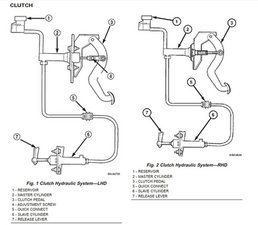Hi Bob,
Okay, let's review how a manual transmission's clutch works and that will help us figure out what's wrong with yours.
First of all, let me disabuse you of the notion that the clutch disk can get "stuck" to the flywheel. No matter what has gone on inside the clutch housing, there is simply nothing that can make those two parts stick together firmly enough that they can overcome all the engine torque you can apply.
That being said, let's look at how it works. The clutch works on the same principle as disk brakes; you take a piece of material and squeeze it between two other pieces in order to stop it from rotating. With the brakes you're squeezing a metal rotor between two pieces of friction material, while a clutch is just the opposite; the pressure plate and flywheel, both made of metal, combine to squeeze the clutch disk (friction material) to stop it from rotating.
When you stop the clutch disk from rotating, you're locking it to the engine so that the engine is now rotating the transmission input shaft at the same speed as the engine is turning.
So it's the pressure plate that opens and closes against the flywheel, clamping and releasing the clutch disk. That's obviously not happening here, so why not? You might think to blame that pressure plate, but it's job is to hold the disk, so when it fails in its job it doesn't hold the disk, meaning you can't get the car to go. You've got the opposite problem in that it won't release the disk, which means the pressure plate is working, so let's continue to see what else is going on.
Now obviously there must be some mechanism to activate the pressure plate, and that's the throw out bearing. That bearing presses against the springs on the pressure plate to open it up and allow the clutch disk to rotate. The throw out bearing is just that; a bearing that spins and allows you to press in against a rotating object (the pressure plate). When a throw out bearing fails you may hear noises when you press on the clutch, the pedal can become difficult to press down, it can make it hard to shift gears, and ultimately can result in total clutch failure. So the throw out bearing is a definite suspect here.
Finally, you need a mechanism to push that throw out bearing against the pressure plate. That's usually accomplished by a lever that gets activated by a hydraulic cylinder in modern cars; older cars sometimes used mechanical linkage to do the same job. Either way the function is to transfer the force pressing on the clutch pedal down to the lever on the transmission. Obviously if that mechanism fails then the throw out bearing won't press on the pressure plate and the clutch disk won't be released. So you'll need to check if that's working; the easiest way is to have someone press on the clutch pedal while you get down to where you can visually monitor the lever and watch for physical movement.
Either type of linkage may require adjustment; provisions for that are always made to account for wear on the clutch disk. In a hydraulic system seals can fail and thus not be able to build up pressure to move the clutch lever. If that happens either the master or slave cylinder would need to be replaced or rebuilt and the system bled like you would bleed brakes.
So check and see if the clutch lever is working first of all; what you find there will decide whether you may be able to fix the issue externally or if you're going to have to remove the transmission to replace the clutch in order to solve the problem. Come back and update your question with the results of what you find and we'll see what the next step for you should be.
War diese Antwort hilfreich?
Bewertet
Rückgängig machen
Bewertung
1
Abbrechen
Schau durch den Thread, bis du den richtigen Platz für diesen Kommentar gefunden hast. Klicke dann auf "Den Kommentar diesem Post zuordnen", um ihn zu verschieben.



 124
124  44
44  90
90 

2 Kommentare
@bobmct what makes you think it is stuck? What does or does it not do?
von oldturkey03
@bobmct Just to check, you can put the transmission in neutral, right? I'm trying to make sure it's a clutch issue rather than a transmission problem.
von Jerry Wheeler